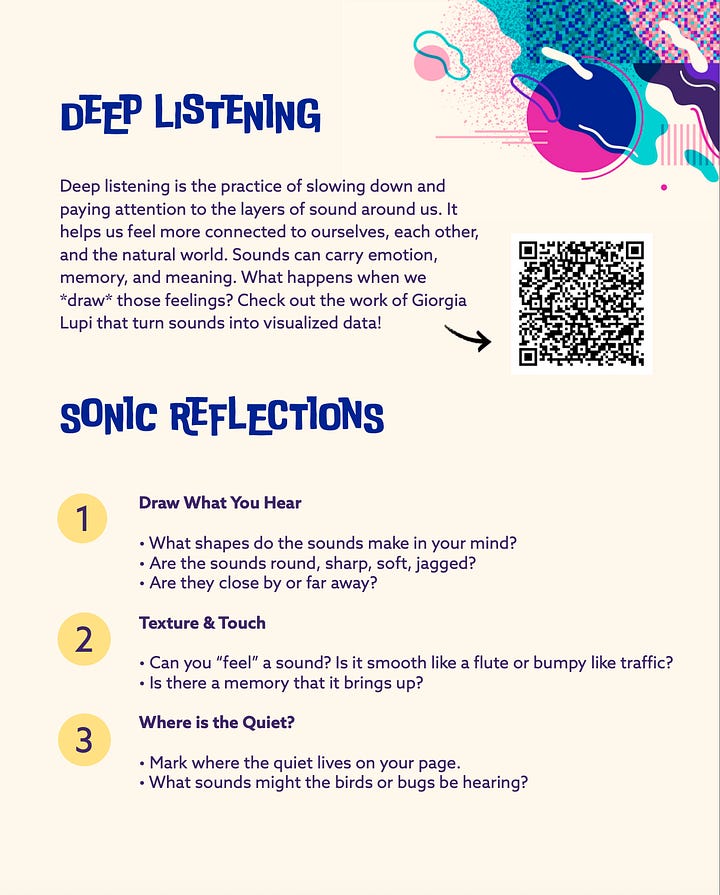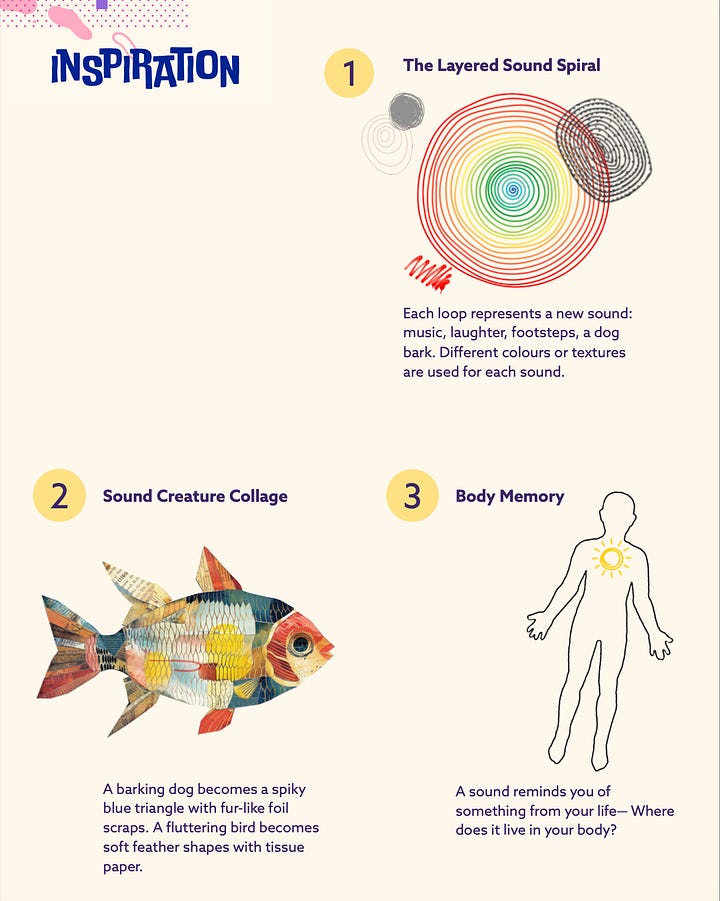What happens when we really listen? Not just passively hearing the world as background noise — but actually tuning in, with our whole selves. What opens up when we allow sound to move through not just our ears, but our memories, our breath, our imaginations? What opportunities might appear in the spaces we habitually overlook?
Today, July 17th (5:00–8:30pm) and again on Sunday, August 24th (12:30–4:30pm), I’ll be inviting folks into a new experiment — a practice of deep listening and sonic mapping as part of Parkway Alive — a summer-long pilot project reimagining sections of the BC Parkway as spaces to gather, play, rest, and explore. I’ll be set up near Metrotown — entrance off Central Blvd, with McKay Avenue as the closest cross street — and if you’re nearby, I’d love for you to drop in and join me.
The seed for this activation started bubbling during a chat with artist Ross Birdwise earlier this year. Ross works at posAbilities' Alternative Creations Studio, the same space where I was running my Emotion Cartography cohort. While the weekly “data collectors” I designed had a sound component, I found myself wishing I had more language to help people deepen their connection to what they were hearing. Lucky for me, Ross — who draws from a rich background in throat singing, experimental music production, and even lending his voice to metal horror projects — shared the ways he’s been working with artists he supports at the studio to interpret sound through visual language — facilitating the creation of “sonic scores”: abstract drawings full of gesture, texture, volume cues, colour, and symbolic representation. Then, using his voice and a loop station, he interprets those drawings as layered soundscapes. He even showed me some pieces by another composer inspired by spring warblers, where each note rose and fell like tiny wings darting through the air.
That conversation really stuck with me. It made me want to pay closer attention to the ways sound impacts my inner landscapes. And then, while I was in the Yukon earlier this month, it hit me again — how the twinkling of thousands of willow leaves delighted my spirit, how the movement of wind through the trees became a kind of visible sound. The canopy became a soft percussion section, dancing with birdsong. As a tried to move my brushes to capture the sound, it touched places in me I didn’t know needed touching — calmed my nervous system, soothed something in my chest.
Composer and sound pioneer Pauline Oliveros wrote about this kind of noticing as Deep Listening — a practice she described as “a life-long practice… the key to multi-level existence.” She understood listening as something expansive: not just tuning into external sounds, but opening to thought, memory, sensation. “Deep Listening,” she said, “takes us below the surface of our consciousness and helps to change or dissolve limiting boundaries.” It’s about shifting our attention in a way that allows for presence. For connection. For feeling.
That really struck me.
Because sound is always there — but so often, we tune it out. Or it overwhelms us. Or we just move through it, distracted. Deep Listening is about staying with it. Expanding our perception. Noticing the shifts in tone and texture. Feeling how vibrations register not just in our ears, but in our chest, our shoulders, our imagination. And seeing what emerges when we offer that kind of attention to ourselves and our surroundings.
In many ways, Parkway Alive feels like a form of collective listening — a citywide pause to consider what this space could become when we treat it not just as a corridor to pass through, but as a place for the “community’s needs and aspirations”. The BC Parkway is a 26-kilometre multi-use path that runs alongside the Expo SkyTrain Line, connecting Vancouver to Surrey. This particular stretch, from Boundary Road to Royal Oak, is currently being studied through the BC Parkway Framework Plan — which included two rounds of community consultation in 2024 to better hear how the space could reflect the dreams of the people who use it. Check out more about the process on the Your Voice page.
So I’m bringing this inquiry — this practice — back to the city. To this in-between space where the hum of traffic mingles with footsteps, snippets of conversation, the occasional bike bell, a tarp catching the wind. Together, we’ll slow down and create “sonic maps”: simple drawings that capture not what something looks like, but what it feels like to hear it. No art experience needed. Just curiosity, a willingness to be present, and maybe a desire to experience your surroundings — and yourself — a little differently.
As Oliveros said, “We open in order to listen to the world as a field of possibilities.”






